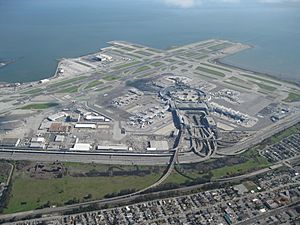Infrastructure facts for kids

Infrastructure is a big word for all the basic things a country or city needs to work well. Think of it as the backbone of modern life! It includes all the important buildings and systems that help people live, work, and travel every day.
These essential things include things like water pipes and sewage systems. It also covers roads, bridges, and railways that help us get around. Other key parts are airports, cable networks for communication, and places to get food.
Infrastructure also means important public places like schools, hospitals, and community centers. Even business and government buildings are part of it. Basically, it's everything built that modern life depends on.
Infrastructure is strongly linked to how well people live, which is called their standard of living. It's also connected to how many people live in an area, known as overpopulation.
Contents
Why Infrastructure Matters
Infrastructure is super important because it helps people live comfortably and safely. Good infrastructure means clean water, easy travel, and access to important services. It supports jobs, businesses, and the overall economy of a place.
Connecting People and Places
One of the main jobs of infrastructure is to connect people and places. Roads, bridges, and railways allow us to travel for work, school, or fun. Airports help us fly to distant places. These connections make it easier to move goods and services too.
Keeping Us Healthy and Safe
Clean water systems and sewage plants are vital for public health. They stop diseases from spreading. Hospitals are also key infrastructure, providing medical care when we need it. Good roads help emergency services like ambulances and fire trucks reach people quickly.
Supporting Daily Life
Think about your daily routine. You probably use water from a tap, electricity for your lights, and the internet to connect with friends. All these things rely on infrastructure. Schools provide education, and community centers offer places for people to gather.
Infrastructure and Population Growth
When more people live in an area, they need more infrastructure. For example, a growing city will need more roads, more water pipes, and more schools. Building this new infrastructure takes time and money.
Challenges in Developing Countries
In some poor countries, the population grows very fast. It can be hard for these countries to build all the infrastructure needed for everyone. This can lead to problems like not enough clean water or crowded roads.
Impact on Standard of Living
When there isn't enough infrastructure, the standard of living can drop. This means people might have less access to clean water or good healthcare. It can also make it harder for emergency services to help people in need.
Types of Infrastructure
Infrastructure can be divided into different types based on what it does.
Transportation Infrastructure
This type helps people and goods move around.
- Roads and Highways: Paths for cars, trucks, and buses.
- Bridges and Tunnels: Structures that help roads cross rivers or mountains.
- Railways: Tracks for trains to carry passengers and cargo.
- Airports: Places where airplanes take off and land.
- Ports: Harbors where ships load and unload goods.
Utilities Infrastructure
These systems provide essential services to homes and businesses.
- Water Supply: Systems that bring clean water to homes and businesses.
- Wastewater Treatment: Plants that clean dirty water before it goes back into the environment.
- Electricity Grids: Networks of power lines that deliver electricity.
- Telecommunications: Systems for phones, internet, and television, like cable networks.
Social Infrastructure
These are places that support community life and well-being.
- Schools: Places for education.
- Hospitals and Clinics: Facilities for healthcare.
- Libraries and Museums: Places for learning and culture.
- Parks and Recreation Centers: Spaces for sports and relaxation.
Other Important Infrastructure
- Housing: Homes and apartments where people live.
- Commercial Buildings: Stores, offices, and other places where businesses operate.
- Government Buildings: Places where public services are managed.
Images for kids
-
San Francisco Ferry Building at night
-
Lehigh Valley Hospital in Allentown, Pennsylvania
See also
 In Spanish: Infraestructura urbana para niños
In Spanish: Infraestructura urbana para niños



